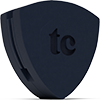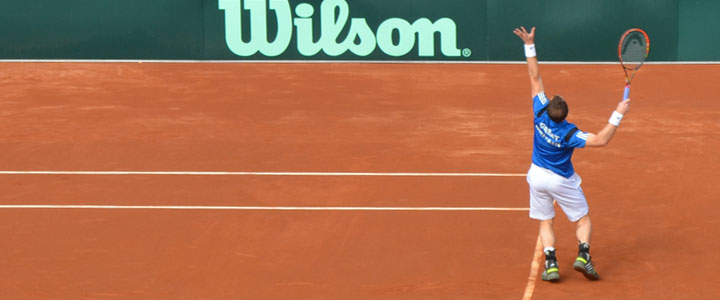Check out my custom vibration dampener
Selecting the Best Tennis Racquet for Tennis Elbow
A Helpful Guide
Recently, one of our awesome community members asked a fantastic question. As a sufferer of golfer’s elbow, he was looking to change his racquet to move toward a frame with a more open string pattern in the hope it would afford him a softer feel and greater potential for spin.
In this article, we’ll take an in-depth look at his question and the elements of a racquet that can help provide relief from golfer’s and tennis elbow. While you’re here, you may also want to check out our guide on the best tennis racquets for 2022.
Article Contents
Click below to jump to a section
Tap below to jump to a section
Tennis & Golfer’s Elbow
Technique, Rest & Recovery
Racquet Weight
Balance
Swing Weight
Racquet Stiffness
Head Size & Length
Strings
String Tension & Pattern
New to TennisCompanion?
Create a free account and explore my latest videos below
Tennis and Golfer’s Elbow
Unfortunately, this scenario is all too common, and if you’re suffering from one of these, you’re not alone. Roughly 1 in 200 players suffers from tennis elbow. Golfer’s elbow, a close cousin, is also common, affecting the inner area of your elbow versus the outer area, which is associated with tennis elbow.
While solving for tennis or golfer’s elbow can be challenging, there are some general guidelines and recommendations that players can consider when selecting a racquet. Let’s take a look.
Technique, Rest & Recovery
Before I jump into some of my recommendations, I’d like to talk about technique and rest to aid in the recovery of tennis or golfer’s elbow symptoms.
If you’re anything like me, you’d rather slap on some Tiger Balm, wear a tennis elbow brace, and pop a few Advil rather than miss a day on the court, but let’s remember – tennis and golfer’s elbow are overuse injuries. As such, we aren’t doing ourselves any favors by pushing through the pain.
So, what can you do?
First and foremost, I’d highly recommend you take an honest look at your technique before spending a bunch of time analyzing your gear. Frequently, you can alleviate tennis and golfer’s elbow by tweaking or developing your technique, which may be putting unnecessary pressure or force on your arm.
Secondly, give yourself time to rest. In many cases, players are forced off the court when the pain gets to be too much. Don’t become this person. Be proactive about your injuries, take time for rest and recovery, and spend some time with your local pro to see if you can make any adjustments that will help with the pain.
If you feel good about where you are with your technique and you’ve given yourself some time to rest, by all means, take a serious look at your equipment.
Racquet Weight
One of the first places to start with is racquet weight or static weight. That is the weight of your unstrung racquet. Generally, a heavier tennis racquet will absorb more shock, so if you’re suffering from tennis elbow or golfer’s elbow, it can be beneficial to use a racquet with more weight. Of course, this is true only to a certain extent.
A good rule of thumb is to find the heaviest racquet weight that you can comfortably swing and make it through a three-set match, but again, you want to be careful not to overdo it with weight. A racquet that’s too heavy can also cause undue stress on your arm and lead to poor technique and contact with the ball.
Many players suffering from tennis elbow will automatically jump to a feather-light racquet, thinking that the weight is the culprit. In many cases, doing so can make the problem worse while at the same time matching you up with a frame that isn’t that great for your game.
Remember, to an extent, weight is your friend when it comes to tennis and golfer’s elbow.
Balance
Similar to weight, tennis racquet balance is a bit of a double-edged sword. On the one hand, more weight in the racquet head will provide stability when hitting, but less weight in the handle can leave you susceptible to shock and vibration traveling through the racquet on contact.
Recognizing this, I’d recommend that you start with a racquet that is a few points head light (HL), while again ensuring the overall weight is as heavy as you can comfortably swing and make it through a three-set match.
Swing Weight
Swing weight is the weight of a racquet as measured when swinging it through the air.
You’re going to want to look for a racquet that has a high enough swing weight without going so high that it would end up leading to poor technique and stress on your arm.
Ultimately, swing weight is a function of racquet weight and balance, so I’d focus on the first two points and recognize that swing weight will increase as you move to a heavier racquet with balance that is head heavy (HH).
Racquet Stiffness
When it comes to racquet stiffness, the general rule you can work with is that stiffer racquets will tend to be harsher on your arm, which is due to both the vibration and shock.
We all know what vibration is, but not everyone associates it with playing tennis. When you make contact with a ball, the energy from striking the ball travels down the frame to your hand, and ultimately your arm – the more rigid or stiff the frame, the more prominent the vibration. You can also think of vibration as the residual or lingering impact from hitting a tennis ball.
Shock, on the other hand, is the more immediate force you feel when coming in contact with a ball. As an extreme example, think of the feeling you get in your arm when you shank a ball – that’s shock.
Combine the two, which are made worse with racquets that have higher stiffness ratings, and you can begin to see how it would wreak havoc on your arm over time.
Head Size and Racquet Length
As the size of a racquet’s head increases, so does the ability for the strings to flex, absorb impact, and deflect energy. If you have the opportunity to go with a slightly larger head size, it could be beneficial.
Length is another factor worth considering. As the length of a racquet increases, so will the pressure, or torque, on your arm when swinging. I’d recommend that you look for a shorter racquet. Most racquets fall between 27 and 29 inches.
String Material & Construction
While strings are not part of the actual frame of a racquet, no conversation on the topic of tennis or golfer’s elbow would be complete without covering them.
As with tennis racquets, the different types of tennis strings vary significantly in material, construction, and thickness, which ultimately has an impact on feel.
When searching for tennis strings, players suffering from tennis or golfer’s elbow should stay away from stiffer material like polyester and opt for softer nylon strings.
Beyond material, string construction is another factor that can contribute to tennis or golfer’s elbow. A great option is multifilament strings, which manufacturers construct by weaving together thousands of microfibers to create a string with a soft, forgiving feel.
String Tension & Pattern
String tension can also have a significant impact on the overall feel of a racquet. Players suffering from tennis or golfer’s elbow may opt for a lower tension to soften the feel and again reduce the overall stiffness of a racquet.
At a lower tension, strings will absorb more energy, resulting in less shock and vibration to your arm. However, the lower the string tension, the less control you have when hitting.
Last but not least, you may also want to take a look at your racquet’s string pattern. Generally, a closed string pattern will provide greater control, less power, and be harder on your arm.
On the other hand, an open string pattern will increase a racquet’s power potential and add to the overall comfort of the racquet but tend to limit control to an extent. Another way to soften the feel of your racquet is to move toward a more open string pattern.
Wrapping Up
As you can see, there’s a lot you can consider when making adjustments to your racquet to accommodate for tennis or golfer’s elbow. Recognizing this, individual players need to weigh the pros and cons of making adjustments to their racquet and strings to reduce the symptoms of tennis or golfer’s elbow.
As you evaluate different options, spend time demoing a variety of racquets. Unfortunately, there is no “best” racquet for tennis elbow, but using these guidelines, players can move toward a racquet that will fit their game while providing some relief from tennis or golfer’s elbow.
Last but not least, remember that your technique might also be contributing to your symptoms. Don’t take the shortcut by switching up your equipment to provide symptomatic relief if there are other long-term fixes that you can implement to prevent it in the first place.
Play Better Tennis
Improve your game alongside our community of tennis players
Why join?
Discussion Boards
Join the conversation with other members of the community.
5 Point Friday
Read our weekly recap of the 5 most interesting things we dig up in tennis.
Trackbacks & Pingbacks
Leave a Reply
Want to join the discussion?Feel free to contribute!



What’s the difference between open and closed string patterns.
Hey Avery,
That’s a great question, thank you for asking.
An open string pattern is one where the strings are spaced farther apart, while a closed string pattern sees the strings spaced closer together. There are two factors that determine how open or closed a string pattern is:
A smaller racquet that has a 95 square inch head with an 18×20 string pattern (18 vertical main strings and 20 horizontal cross strings) will have a very closed string pattern, while a racquet with a 118 square inch head and a 16×19 string pattern will have a very open string pattern.
Generally speaking an open string pattern will provide players with more power, less control and a greater potential for spin since the strings can really dig into the ball on contact. On the flip side a close string patter provides more control, less power and a slightly diminished potential for spin.
In this article I recommend an open string pattern since it will tend to provide a more forgiving string bed – all other things being equal.
Hopefully this helps and thanks again for asking a question :)
All the best,
Jon
Hey, I tend to get tennis elbow when I play a lot of tennis as most amateurs do.
when you say ‘ players jump to a featherweight racquet’ what weight would this be?? 9oz or less? 10oz or less?
and what would be a good weight range to use? I’m of slightly solider build and average height.
and what are the parameters for swing weight? Does it depend on the weight ans balance of a racquet or is there set outlines? e.g. 250-350 etc etc
I’ve been looking to buy a new racquet as my old one is very outdated, and was curious as to know what might help, I’ve had many conflicting results when asking coaches/pros.
Any help is much appreciated thank you.
Hi Cam,
Great questions – thanks for asking!
When I mentioned feather light racquet, I was referring to a racquet that’s 10 ounces or less. Most racquets below 9 ounces will tend to fall in the junior category.
For the build and height you’ve described, using the range of 10.5 – 11.5 ounce as a guide is going to provide you with a wealth of options, but keep an eye on the stiffness rating too. As for swingweight, you’ve got it exactly right – the weight and balance of a racquet will have a direct influence on the racquets overall swing weight.
The tricky part with racquets is that it can be very subjective, so as you’ve mentioned, you’ll get a ton of conflicting opinions on what is or isn’t important. My recommendation for players in your situation is to start with the racquet you have. Do you mind sharing what racquet and strings you are using?
You mentioned you’ve struggled with tennis elbow, so you have good motivation to consider other options. However, as a starting point, it can be helpful to jot down what you like and don’t like about the racquet you have along with the current specs, i.e., weight, stiffness, balance, etc.
If there’s a lot you like about your racquet, you might find you can make adjustments to your current frame such as adding some lead tape and swapping out your strings. Alternatively, there may be another series of racquets for the brand you use that might be worth experimenting. As an example, if you were using the Babolat Pure Drive, you may want to give the less stiff Babolat Pure Strike a try, which brings me to my favorite advice.
Demo as many racquets as you can get your hands on and jot down their specs so you can compare and contrast their feel. There are a lot of variables that go into racquet specs, but nothing beats playing with a racquet to determine whether you like it or not :) Local clubs and tennis shops, as well as online retailers, have demo programs.
If you can share the racquet and strings your using, I’d be more than happy to help point you in the right direction.
Best of luck,
Jon
Hey im suffering from TE from past few years the pain come and go. But during this time I changed many racquets it didnt help non of them finally I got wilson rf autograph 97 sq inch weight 340 gm I like it but nothing is helping at the moment do u think my technique can also be a reason
Hi Sher Singh Shekhawat!
Sorry to hear about your tennis elbow – it’s super frustrating when you can’t find a reasonable solution.
Tennis elbow boils down to three primary causes:
As you’ve pointed out, improper technique can absolutely lead to tennis elbow. Similarly, overuse can lead to tennis elbow. The two combined can wreak havoc on a players arm. With that in mind, it’s definitely worth evaluating your technique to see if there are any trouble spots. My recommendation would be to find a local tennis pro who you can spend an hour with and review all of your strokes to see if there’s anything that stands. In my experience, the serve is often the culprit.
If you’d like to post a link to a video of your tennis, I’d be more than happy to help provide some feedback.
Good luck and let me know how I can help.
All the best,
Jon